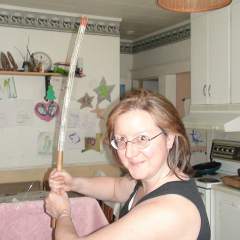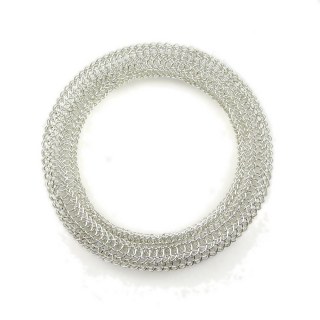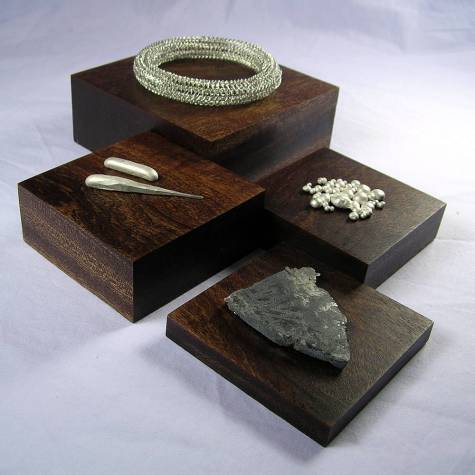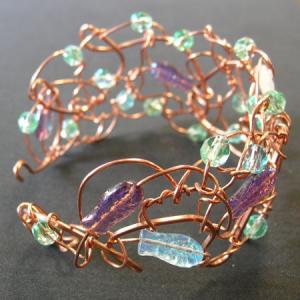PASSAGE: HSTA Faculty Exhibition – June 30-July 30, 2010
There are times when a call for entry with a specific theme is put out and I draw a complete blank. I go through all kinds of contortions trying to come up with some sort of inspiration, and then what I end up with looks equally tortured! So I was really excited when, upon finding out out last summer that the theme for this year’s HSTA Faculty Exhibition was going to be “Passage”, I immediately had an idea.
A former boss made the comment to me once that we are all dependent on the products of mining: “If it can’t be grown, it has to be mined,” he said. While this statement could almost be considered a universal truth, it is particularly true for jewelers.
I wanted to show a piece through various stages of its development – the passage from ore to granule, from granule to ingot, from ingot to wire, from wire to jewelry.
Having attended a number of fine craft exhibitions during my time with The Metal Arts Guild of Canada, one thing that has always struck me is how jewellers have dealt with the issue of effectively displaying something so small.
The first MAG show I attended, Behind Glass (2000), directly challenged the problem by asking everyone to display their pieces in shadow boxes. The pieces I remember were a silhouette of a person – a brooch in silver – attached to a picture of a beach, to give the illusion of it standing at the water’s edge. Another entry was a ring topped by a tiny sewing machine displayed in front of a old photograph of the artist’s grandmother, who loved to sew.
At the most recent exhibition, MAGC 2067: Crafting the Future, several of the artists included supplementary props with their pieces. Anne Lumsden’s piece was displayed over a bed of zebra mussel shells. Rosalyn Woo’s award winning brooch, “Dear Linda” was envisioned as a birthday gift for its fictitious namesake, and included the “letter” written by the “maker”, Jacob. Some might argue that the props detracted from the work – turning them into sculpture rather than jewelry – but for me, it added visual interest and helped to put the pieces into the context of the scenarios they were made to represent.
So, for this year’s HSTA Faculty Exhibition, I decided to approach my submission as jewelry cum sculpture. The pinnacle of the Passage – and the piece that took the longest to construct – is the torus bangle. Despite my ravings last year after a previous attempt at a torus, the thought of trying again appealed to me.
My six year old is currently obsessed with all things LEGO and Star Wars, so when I got the tube to the final length (18″/45 cm) I decided to have a little fun, and took a picture of myself in my best Jedi Princess Warrior pose.
.
My wonderful handyman husband whipped up a wooden drawplate with large holes for me. (He loves it when I give him an excuse to buy tools!) After drawing, the length of the tube was over 40″ (101 cm). The reason I made it that long was to give me extra material in case I had to try again.
The technique for making a seamless join is called kitchener stitching. It’s a common knitting technique for adding pockets to sweaters, or fingers to mittens, etc. It’s tricky to do in wire, because the wire work hardens very quickly and the join tends to have a bit of a bulge.
I made two attempts at tori before finally working out an effective way of keeping the seam from being visible.
The casting grain and ingots gave me an opportunity to feed my own tool fetish: I now have a new ingot mold! *grin*
The silver ore came from a vendor at the Bancroft Gemboree last year. Unfortunately, no locality info was included with the specimen, so I don’t know if the source is a Canadian mine.
The mahogany display blocks play an integral role in delineating the passage through the stages.
I am grateful to be able to work with metal and to make wearable art, and so my submission to the HSTA Faculty Exhibition is really about paying homage.
.
Passage: From Ore to Jewelry (2010)
Silver ore, slabbed
Grains, 18.43 g, sterling silver, cast
Ingot, sterling silver, cast, 6.844 g
Ingot, sterling silver, cast, forged, drawn, 7.992 g
Torus, sterling silver, viking knit, kitchener stitching, 1.3 cm tube, 8.5 cm OD
Displays, mahogany wood, danish oil finish, various sizes
Every piece of jewelry is the end of a journey. The metal forms as ore deep underground. It is mined, extracted and formed into granules, then melted and cast into ingots. The ingots are compressed and made into a usable shape. In this case, it was drawn into wire, then knitted into a torus.
We see and admire only the final form, and acknowledge only the artist whose name is attached to it; yet the piece has been touched by many hands. I wanted to recognize and thank those who labour behind the scenes to bring my jewelry into being.
.
PASSAGE: HSTA Faculty Exhibition
Rails End Gallery & Arts Centre
23 York Street
Haliburton, Ontario, K0M 1S0
June 30 – July 30, 2009
www. railsendgallery.com







I signed up for your website to post this comment. 🙂
So… hello! Hehehe
I’ve decided to put everything aside and visiting everyone of my jewelry making friends tonight, and instead of lurking I am going to tell you how I’ve enjoyed reading your blog.
Your Jedi Princess Warrior pose made me laugh. Thanks Dianne.
Corra
http://jewelry.de-cors.com
Hehehe – thanks for the visit Corra!